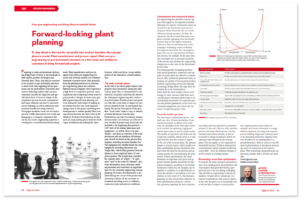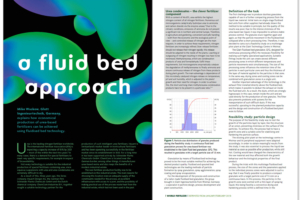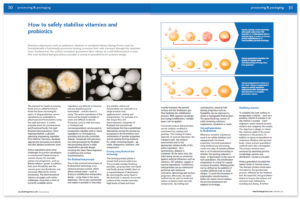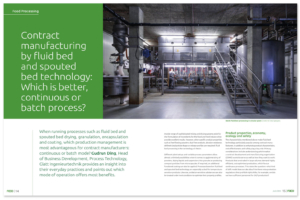Design and operation of energy-efficient fluid bed systems – Integrated approach saves costs
Systems for agglomeration, spray granulation and coating in the fluid bed are used in nearly all industries with the production and refinement of solid product forms. In addition to the material and application properties of the manufactured products their manufacturing costs can also be significantly influenced already during the design of the fluid bed systems.
- Author: Dr. Michael Jacob, Head of Process Technology Food, Feed & Fine Chemicals, Glatt Ingenieurtechnik GmbH
- originally published in the trade magazine ‘cpp – chemical plants & processes’, issue 01/2013, Konradin-Verlag Robert Kohlhammer GmbH
and Integrated approach saves costs (process-technology-online.com)
Different methods can be employed for the energy optimization of complex systems. For example, Glatt Ingenieurtechnik has been using the flow schema simulation for many years to perform effective studies of different system configurations, study the effects of changing process parameters or to compare different system concepts. Such analyses must be performed dynamically when the process conditions change dependent on a time factor, which, for example, is the case with batch or semi-continuous processes. Accordingly, energetic optimization is very complex and elaborate to this end. In addition, such processes – because of the cyclically returning start-up and shut-down processes – hardly provide the possibility of performing dimensioning to an optimal operating point. By contrast, fluid bed systems with continuous process management achieve a stationary condition where the process-related parameters (temperatures, air volumes, pressures, mass flows…) no longer change depending on the time. Thus the operating point is clearly defined for a process, which largely simplifies the simulations and allows for reliable optimization studies.
A typical simplified flow diagram of a continuous fluid bed granulation system is depicted in Figure 1. In the simplest scenario, the required process air volume can be applied by a single ventilator. Although this solution is technically simple, it may require large ventilators with high connection ratings in case of large systems. Dividing the total required pressure jump to two ventilators to limit the respective ventilator sizes and to utilize the energy provision of the pressure ventilator for the process (Fig. 2) is therefore often technologically and energetically more efficient. The utilization of the process waste heat of the fluid bed apparatus has become increasingly established during the past year in industrial practice. Two basic principles, shown in Fig. 3 and Fig. 4, are available here. The version to be preferred in each case depends on the temperature profile within the system as well as the room conditions or also the safety aspects.
The definition of the respective optimal concept must be made based on case studies where energy savings and the associated investments as well as the spatial basic conditions are considered. The system operation itself must be viewed under the aspects of falling below the dew point, winter operation as well as maintenance, corrosion and ease of cleaning. The circulation of process air represents another approach of lowering the heating energy demand of a fluid bed system. Part of the exhaust air from the fluid bed apparatus is utilised here to be added to the usually colder fresh air. Figure 5 shows a schema where an adjustable portion of the exhaust air is used to minimise the energy demand of the heating system. With the overall energy consideration both the effects on the dimensioning of the total air-related equipment as well as the effects on the granulation process must be taken into account. For example, the return of a partial flow causes an increase of the relative humidity at the intake of the granulator. It must now be examined here whether this will affect the granulator growth or, depending on the sorption properties, also the achievable product moisture. By contrast, a system configuration is shown in Fig. 6 where the entire process air volume is carried in circulation. This mode requires that the moisture introduced through the fluid injection into the granulation system (usually water or organic solvents) is removed again by a condenser. Only minimal fresh air supply (or also inert gas volume) is required in this case. The air or gas volume to be taken out of circulation depends essentially on the volumes supplied from external sources or through injection.
Customer-specific optimised solutions
The choice of the respective concept depends very much on the application and particularly scenario. For example, a decision for partial or complete circulation of the process gas can be made based on:
- Material properties of the product (e.g. oxygen sensitivity, sorption behaviour…)
- Safety aspects (e.g. explosion hazard, protection of the product, emission…)
- Energetic optimization (e.g. lowering of the heating capacity…)
- Limitations on the exhaust air volume (e.g. max. emission volume, connection to downstream systems for exhaust gas cleaning…).
Sample calculations were performed to explain the saving potentials. The results are depicted in Fig. 7. To facilitate easy comparison all values were normalised, i.e. shown in relationship to the fresh air handling according to Fig. 1.
A constant process air mass flow of 10 000 kg/h was defined for the comparative study and a steam evaporation output of 500 kg/h was calculated. The required intake temperature for the fluid bed apparatus was calculated for each configuration according to the demand to always ensure a comparable temperature of the fluid bed of 75 °C. The different air volume flows and the required heating capacity are compared. The fresh air mode thereby represents the reference base. It becomes apparent that a partial flow return without condensation (Fig. 5) can significantly reduce the emission values and heating energy demand.
The possible circulation volume depends on the material properties of the respective product as well as the thermal conditions in the system. In the present example the partial returns correspond approx. to 50 % (Ver. 1) 70 % (Ver. 2) of the total air volume. The required heating capacities could be reduced to 86 % and 79 %, respectively, of the demand of the fresh air mode. This reduction directly lowers the process costs. Additional savings follow from the lower supply and exhaust air volumes where the respective required equipment can be chosen to be smaller and with lower investment and operating costs. The process-related basic conditions for the concrete application must be determined during the development phase of a project through experimental studies with laboratory units and pilot systems. In this project stage laboratory analyses (e.g. DVS, TGA, DSC…) can be used as supplement to define the possible parameter range for the process management. The combination from analysis, trial operation and process simulation thereby facilitates the development of customer-specific optimised solutions. As integrated system provider Glatt Ingenieurtechnik offers their customers the full range of services from concept to process development, engineering of system equipment and buildings all the way to the complete delivery of entire production facilities. This integrated approach offers additional potentials for energy optimization beyond the framework of process technology. For example, process waste heat in many cases can be used to heat media flows or for air conditioning and ventilation equipment. Vice versa, the energetic coupling of systems for the media supply (e.g. compressors, refrigeration systems…) also offers several options of utilising the waste heat not used there, for example, to preheat the fluid bed system.
Further information on this topic and related topics can also be found in the following publications:
Published article: ‚Forward-looking plant planning – How pre-engineering can bring ideas to market faster‘ PDF, English
Published article: ‘Process Technologies to Optimize Detergent Manufacturing’. PDF, English
Published article: ‘A Fluid Bed Approach – Case study on the economical production of urea-based fertilizers can be achieved using fluidised bed technology’ PDF, English
Published article: ‘Hot-melt applications for the food and beverage industry – How to safely stabilize vitamins and probiotics’ PDF, English
Published article: ‘Contract manufacturing by fluid bed and spouted bed technology: Which is better, continuous or batch process?’ PDF, English







 Copyright: VOGEL Communications Group GmbH & Co. KG
Copyright: VOGEL Communications Group GmbH & Co. KG Copyright: Hüthig GmbH
Copyright: Hüthig GmbH